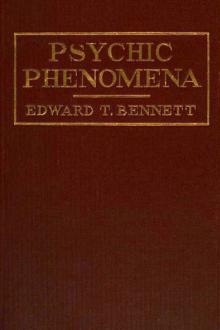The Beautiful by Vernon Lee (red queen free ebook .txt) 📖

- Author: Vernon Lee
- Performer: -
Book online «The Beautiful by Vernon Lee (red queen free ebook .txt) 📖». Author Vernon Lee
A further illustration of the principle that shape-perception is a combination of active measurements and comparisons, and of remembrance and expectations, is found in a fact which has very great importance in all artistic dealings with shapes. I have spoken, for simplicity's, sake, as if the patches of colour on a blank (i.e. uninteresting) ground along which the glance sweeps, were invariably contiguous and continuous. But these colour patches, and the sensations they afford us, are just as often, discontinuous in the highest degree; and the lines constituting a shape may, as for instance in constellations, be entirely imaginary. The fact is that what we feel as a line is not an objective continuity of colour-or-light-patches, but the continuity of our glance's sweep which may either accompany this objective continuity or replace it. Indeed such imaginary lines thus established between isolated colour patches, are sometimes felt as more vividly existing than real ones, because the glance is not obliged to take stock of their parts, but can rush freely from extreme point to extreme point. Moreover not only half the effectiveness of design, but more than half the efficiency of practical life, is due to our establishing such imaginary lines. We are inevitably and perpetually dividing visual space (and something of the sort happens also with "musical space") by objectively non-existent lines answering to our own bodily orientation. Every course, every trajectory, is of this sort. And every drawing executed by an artist, every landscape, offered us by "Nature," is felt, because it is measured, with reference to a set of imaginary horizontals or perpendiculars. While, as I remember the late Mr G. F. Watts showing me, every curve which we look at is felt as being part of an imaginary circle into which it could be prolonged. Our sum of measuring and comparing activities, and also our dramas of remembrance and expectation, are therefore multiplied by these imaginary lines, whether they connect, constellation-wise, a few isolated colour indications, or whether they are established as standards of reference (horizontals, verticals, etc.) for other really existing lines; or whether again they be thought of, like those circles, as wholes of which objectively perceived series of colour patches might possibly be parts. In all these cases imaginary lines are felt, as existing, inasmuch as we feel the movement by which we bring them into existence, and even feel that such a movement might be made by us when it is not.
So far, however, I have dealt with these imaginary lines only as an additional proof that shape-perception is an establishment of two dimensional relationships, through our own activities, and an active remembering, foreseeing and combining thereof.
CHAPTER VII
FACILITY AND DIFFICULTY OF GRASPING
OF this we get further proof when we proceed to another and less elementary relationship implied in the perception of shape: the relation of Whole and Parts.
In dealing with the ground upon which we perceive our red and black patches to be extended, I have already pointed out that our operations of measuring and comparing are not applied to all the patches of colour which we actually see, but only to such as we look at; an observation equally applicable to sounds. In other words our attention selects certain sensations, and limits to these all that establishing of relations, all that measuring and comparing, all that remembering and expecting; the other sensations being excluded. Now, while whatever is thus merely seen, but not looked at, is excluded as so much blank or otherness; whatever is, on the contrary, included is thereby credited with the quality of belonging, that is to say being included, together. And the more the attention alternates between the measuring of included extensions and directions and the expectation of equivalent (symmetrical or rythmical) extensions or directions or stresses, the closer will become the relation of these items included by our attention and the more foreign will become the excluded otherness from which, as we feel, they detach themselves. But—by an amusing paradox—these lines measured and compared by our attention, are themselves not only excluding so much otherness or blank; they also tend, so soon as referred to one another, to include some of this uninteresting blankness; and it is across this more or less completely included blankness that the eye (and the imagination!) draw such imaginary lines as I have pointed out with reference to the constellations. Thus a circle, say of red patches, excludes some of the white paper on which it is drawn; but it includes or encloses the rest. Place a red patch somewhere on that enclosed blank; our glance and attention will now play not merely along the red circumference, but to and fro between the red circumference and the red patch, thereby establishing imaginary but thoroughly measured and compared lines between the two. Draw a red line from the red patch to the red circumference; you will begin expecting similar lengths on the other sides of the red patch, and you will become aware that these imaginary lines are, or are not, equal; in other words, that the red patch is, or is not, equidistant from every point of the red circumference. And if the red patch is not thus in the middle, you will expect, and imagine another patch which is; and from this imaginary centre you will draw imaginary lines, that is you will make by no means imaginary glance-sweeps, to the red circumference. Thus you may go on adding real red lines and imaginary lines connecting them with the circumference; and the more you do so the more you will feel that all these real lines and imaginary lines and all the blank space which the latter measure, are connected, or susceptible of being connected, closer and closer, every occasional excursion beyond the boundary only bringing you back with an increased feeling of this interconnexion, and an increased expectation of realising it in further details. But if on one of these glance-flickings beyond the circumference, your attention is caught by some colour patch or series of colour patches outside of it, you will either cease being interested in the circle and wander away to the new colour patches; or more probably, try to connect that outlying colour with the circle and its radii; or again failing that, you will "overlook it," as, in a pattern of concentric circles you overlook a colour band which, as you express it "has nothing to do with it," that is with what you are looking at. Or again listening to. For if a church-bell mixes its tones and rythm with that of a symphony you are listening to, you may try and bring them in, make a place for them, expect them among the other tones or rythms. Failing which you will, after a second or two, cease to notice those bells, cease to listen to them, giving all your attention once more to the sonorous whole whence you have expelled those intruders; or else, again, the intrusion will become an interruption, and the bells, once listened to, will prevent your listening adequately to the symphony.
Moreover, if the number of extensions, directions, real or imaginary lines or musical intervals, alternations of something and nothing, prove too great for your powers of measurement and comparison, particularly if it all surpass your habitual interplay of recollection and expectation, you will say (as before an over intricate pattern or a piece of music of unfamiliar harmonies and rythm) that "you can't grasp it"—that you "miss the hang of it." And what you will feel is that you cannot keep the parts within the whole, that the boundary vanishes, that what has been included unites with the excluded, in fact that all shape welters into chaos. And as if to prove once more the truth of our general principle, you will have a hateful feeling of having been trifled with. What has been balked and wasted are all your various activities of measuring, comparing and co-ordinating; what has been trifled with are your expectations. And so far from contemplating with satisfaction the objective cause of all this vexation and disappointment, you will avoid contemplating it at all, and explain your avoidance by calling that chaotic or futile assemblage of lines or of notes "ugly."
We seem thus to have got a good way in our explanation; and indeed the older psychology, for instance of the late Grant Allen, did not get any further. But to explain why a shape difficult to perceive should be disliked and called "ugly," by no means amounts to explaining why some other shape should be liked and called "beautiful," particularly as some ugly shapes happen to be far easier to grasp than some beautiful ones. The Reader will indeed remember that there is a special pleasure attached to all overcoming of difficulty, and to all understanding. But this double pleasure is shared with form-perception by every other successful grasping of meaning; and there is no reason why that pleasure should be repeated in the one case more than in the other; nor why we should repeat looking at (which is what we mean by contemplating) a shape once we have grasped it, any more than we continue to dwell on, to reiterate the mental processes by which we have worked out a geometrical proposition or unravelled a metaphysical crux. The sense of victory ends very soon after the sense of the difficulty overcome; the sense of illumination ends with the acquisition of a piece of information; and we pass on to some new obstacle and some new riddle. But it is different in the case of what we call Beautiful. Beautiful means satisfactory for contemplation, i.e. for reiterated perception; and the very essence of contemplative satisfaction is its desire for such reiteration. The older psychology would perhaps have explained this reiterative tendency by the pleasurableness of the sensory elements, the mere colours and sounds of which the easily perceived shape is made up. But this does not explain why, given that other shapes are made up of equally agreeable sensory elements, we should not pass on from a once perceived shape or combination of shapes to a new one, thus obtaining, in addition to the sensory agreeableness of colour or sound, a constantly new output of that
 A very interesting statement of one of our contemporaries is that any person, to one degree or another, is both a psychologist and a philosopher - they say, life forces him to. On the one hand, the main driving force of every person is the craving for knowledge, the desire to reach certain social heights, the desire to be wise in any everyday situations - and this is the philosophy of life.
A very interesting statement of one of our contemporaries is that any person, to one degree or another, is both a psychologist and a philosopher - they say, life forces him to. On the one hand, the main driving force of every person is the craving for knowledge, the desire to reach certain social heights, the desire to be wise in any everyday situations - and this is the philosophy of life. 




Comments (0)